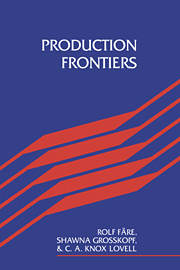Book contents
- Frontmatter
- Contents
- List of Figures
- List of Tables
- Preface
- 1 Introduction
- 2 Production Technology
- 3 Input-Based Efficiency Measurement
- 4 Output-Based Efficiency Measurement
- 5 Indirect Input-Based Efficiency Measurement
- 6 Indirect Output-Based Efficiency Measurement
- 7 The Measurement of Price Efficiency
- 8 Graph Efficiency Measurement
- 9 Efficiency Measurement and Productivity Measurement
- 10 Topics in Efficiency Measurement
- A Standard Notations and Mathematical Appendix
- References
- Biographical Index
- Index
6 - Indirect Output-Based Efficiency Measurement
Published online by Cambridge University Press: 23 October 2009
- Frontmatter
- Contents
- List of Figures
- List of Tables
- Preface
- 1 Introduction
- 2 Production Technology
- 3 Input-Based Efficiency Measurement
- 4 Output-Based Efficiency Measurement
- 5 Indirect Input-Based Efficiency Measurement
- 6 Indirect Output-Based Efficiency Measurement
- 7 The Measurement of Price Efficiency
- 8 Graph Efficiency Measurement
- 9 Efficiency Measurement and Productivity Measurement
- 10 Topics in Efficiency Measurement
- A Standard Notations and Mathematical Appendix
- References
- Biographical Index
- Index
Summary
Introduction
The purpose of this chapter is to extend the radial output-based efficiency measures in Chapter 4, where efficiency of the observed output vector is judged relative to technology with fixed inputs, to the case in which outputs are judged relative to the cost indirect production technology. In this case, inputs are restricted but not fixed, they may vary as long as their cost does not exceed a prespecified target. In contrast, in Chapter 4, inputs are assumed exogenously given and fixed.
In Section 6.1, measures of indirect output-based technical efficiency are developed. These measures take input prices and planned cost as given and measure efficiency as proportional expansion of all outputs. The (C, S) measure is then decomposed into component measures of scale efficiency, congestion, and purely technical efficiency, all relative to the cost indirect technology.
In Section 6.2 we introduce output prices and obtain a cost indirect output revenue efficiency measure. This measure gauges the extent to which a producer succeeds in maximizing output revenue when constrained by output prices, input prices, and an input budget. This cost indirect revenue efficiency measure is then decomposed into technical and allocative components, the technical component being the measure introduced in Section 6.1.
In Section 6.3 we present a measure of revenue effectiveness, which shows the ability of a producer to convert an input budget into revenue.
In Section 6.4 our artificial data set is used to illustrate some of the cost indirect output efficiency measures developed in this chapter.
- Type
- Chapter
- Information
- Production Frontiers , pp. 153 - 176Publisher: Cambridge University PressPrint publication year: 1993



